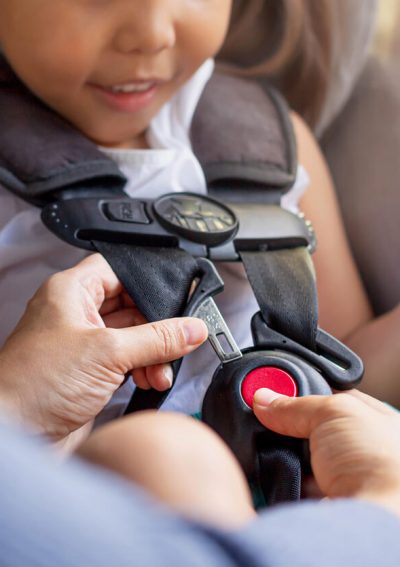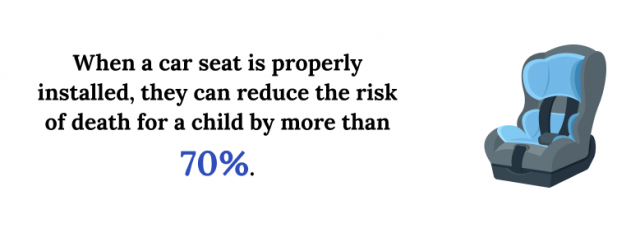Car Seat Safety
Car seats are an integral part of child safety, especially for children under the age of 13. When installed properly, they can reduce the risk of death for a child by more than 70%. Unfortunately, however, more than half of all car seats are either installed or used improperly.

Additionally, car seats are not one size fits all. As they grow, children will require different car seats that are appropriate for their height, weight and age in order to ensure they are safe while in the vehicle. Providing children with appropriate car seats and following common-sense traffic safety precautions is an easy way to prevent these tragedies.

Stage 1: Rear-Facing Car Seats
Experts agree that starting from birth, young children should be secured in rear-facing car seats. Rear-facing car seats are equipped with harnesses that, in the event of a crash, are designed to reduce stress on the neck and spinal cord.
Children grow at different rates. Some children will outgrow rear-facing car seats faster than others. Children typically outgrow rear-facing car seats between the ages of 2 and 4, but it is essential that children remain in these rear-facing seats until they reach the appropriate height and weight limit. This is the case even if the child begins to experience some leg crowding.
Rear-facing car seats should always be placed in the back seat of the vehicle, never in the front passenger seat. Parents with only one car seat in the vehicle should install the car seat in the middle of the back row if possible in the model of their vehicle.
Additionally, the National Highway and Traffic Safety Association (NHTSA) has a car seat finder for parents who are unsure of how to choose the right car seat for their child’s needs.
Stage 2: Forward-Facing Car Seats
When children outgrow their rear-facing car seats, they should then be placed in a forward-facing car seat. Forward-facing car seats are designed to cradle the child and stop their forward motion in the event of a crash
Some rear-facing car seats are convertible or “all-in-one” and can simply be turned around once the child reaches the appropriate size. Do not turn the rear-facing car seat around unless the manufacturer expressly permits it. Children typically remain in these seats until the age of 5, however, some seats can accommodate children who weigh up to 65 pounds.
Like rear-facing car seats, forward-facing car seats should always be in the backseat of the vehicle and in the middle seat if possible.
Stage 3: Booster Seats
When the child outgrows their forward-facing car seat they should then be given a booster seat. Unlike rear and forward-facing car seats, booster seats utilize the vehicle’s seat belts.
When using booster seats, ensure that the lap belt lies across the child’s hips, touching their upper thighs, while the shoulder belt lies across their chest.
Booster seats should always be placed in the backseat of the vehicle. No child under the age of 13 should ever be permitted in the front passenger seat.
Booster seat usage in children between the ages of 4 and 7 is declining. Children and parents are faced with a similar social pressure surrounding child development. Children may feel self-conscious about using a booster seat while their peers do not, however it is vital that parents prioritize their safety.
Until the child is tall enough to wear the seat belt properly, they should remain in the booster seat, regardless of their age. The proper seat belt fit typically does not happen until the child reaches around 4 feet, 9 inches tall.
Stage 4: Seat Belts
Only once the child is tall enough to wear the seat belt properly should they be permitted to go without the booster seat. The seat belt should lie across the child’s hips and chest. Never permit the child to wear the shoulder belt behind their neck or under their arms.
If they can’t wear the seat belt properly, they are not tall enough to solely rely on it for protection in the event of a crash. Do not use after-market seat belt adjusters to reposition the seatbelt for your child as they may not be safe.
Just because a child no longer needs a booster seat does not mean they should be permitted in the passenger seat. Until the age of at least 13, children should always remain in the back seat and in the center of the row if possible.
Car Seat Defects
In order to ensure your child is safe in the vehicle, the car seat itself must be capable of protecting the child in the event of a crash. Do not use car seats that:
- The manufacturer has recalled. The National Highway Traffic and Safety Administration has a Child Seat Recall Campaign Listing that tracks every recalled seat from the previous ten years.
- Are visibly cracked.
- Are missing a label, parts, or instructions.
- Are outdated.
- Have been in a previous car accident.
Using an inadequate car seat puts children at extremely high risk of injury in the event of a crash. Proper car seat usage greatly reduces the risk of death.
Other Factors to Consider
Car seats have many usages and should never be substituted for a vehicle-provided safety feature like airbags. Additionally, car seats can protect children both inside and outside personal vehicles.
Airbags
While airbags are used to protect adults in the event of a crash, they should never be relied on as an alternative for car seats. Airbags deploy at the speed of roughly 200 miles an hour which could inflict serious injuries to the head and neck of a child.
Public Transportation
The Federal Aviation Administration (FAA) recommends that all children below 40 pounds are restrained during takeoff, turbulence and landing to prevent injury. Most rear and forward-facing car seats are permitted on airplanes to secure children in flight.
Buses, trains, taxis and ride-share services pose similar threats to child safety and car seats protect children from injury there as well. Convertible car seats are typically large and heavy, making them difficult to transport and use on different forms of public transportation, which is something to consider when purchasing your child’s car seat. Parents who do not own a personal vehicle may be better off purchasing less heavy alternatives to convertible seats to avoid these concerns.
7 Cited Research Articles
Consumernotice.org adheres to the highest ethical standards for content production and references only credible sources of information, including government reports, interviews with experts, highly regarded nonprofit organizations, peer-reviewed journals, court records and academic organizations. You can learn more about our dedication to relevance, accuracy and transparency by reading our editorial policy.
- Centers for Disease Control & Prevention (2021, September 15). Keep Child Passengers Safe. Retrieved from https://www.cdc.gov/injury/features/child-passenger-safety/index.html
- Car Safety Seats Guide. (2021, July 14). Car Seats: Information for Families. Retrieved from https://www.healthychildren.org/English/safety-prevention/on-the-go/Pages/Car-Safety-Seats-Information-for-Families.aspx
- Mayo Clinic. (2020, October 21). Infant and toddler health. Retrieved from https://www.mayoclinic.org/healthy-lifestyle/infant-and-toddler-health/in-depth/car-seat-safety/art-20043939
- National Highway Traffic and Safety Administration. (2018, September). The 2017 National Survey of the Use of Booster Seats. Retrieved from https://crashstats.nhtsa.dot.gov/Api/Public/ViewPublication/812617.pdf
- Lacey, Sarah. (2014, March 5). Bye-Bye Booster: What You Should Know About Seat Belts and Older Kids. Retrieved from https://www.cars.com/articles/bye-bye-booster-what-you-should-know-about-seat-belts-and-older-kids-1420663027113/
- National Highway Traffic and Safety Administration. (n.d.). Car Seats and Booster Seats. Retrieved from https://www.nhtsa.gov/equipment/car-seats-and-booster-seats
- Safe Kids Worldwide. (n.d.). Car Seat Safety Tips. Retrieved from https://www.safekids.org/car-seat
Calling this number connects you with a Consumer Notice, LLC representative. We will direct you to one of our trusted legal partners for a free case review.
Consumer Notice, LLC's trusted legal partners support the organization's mission to keep people safe from dangerous drugs and medical devices. For more information, visit our partners page.
844-420-1914
